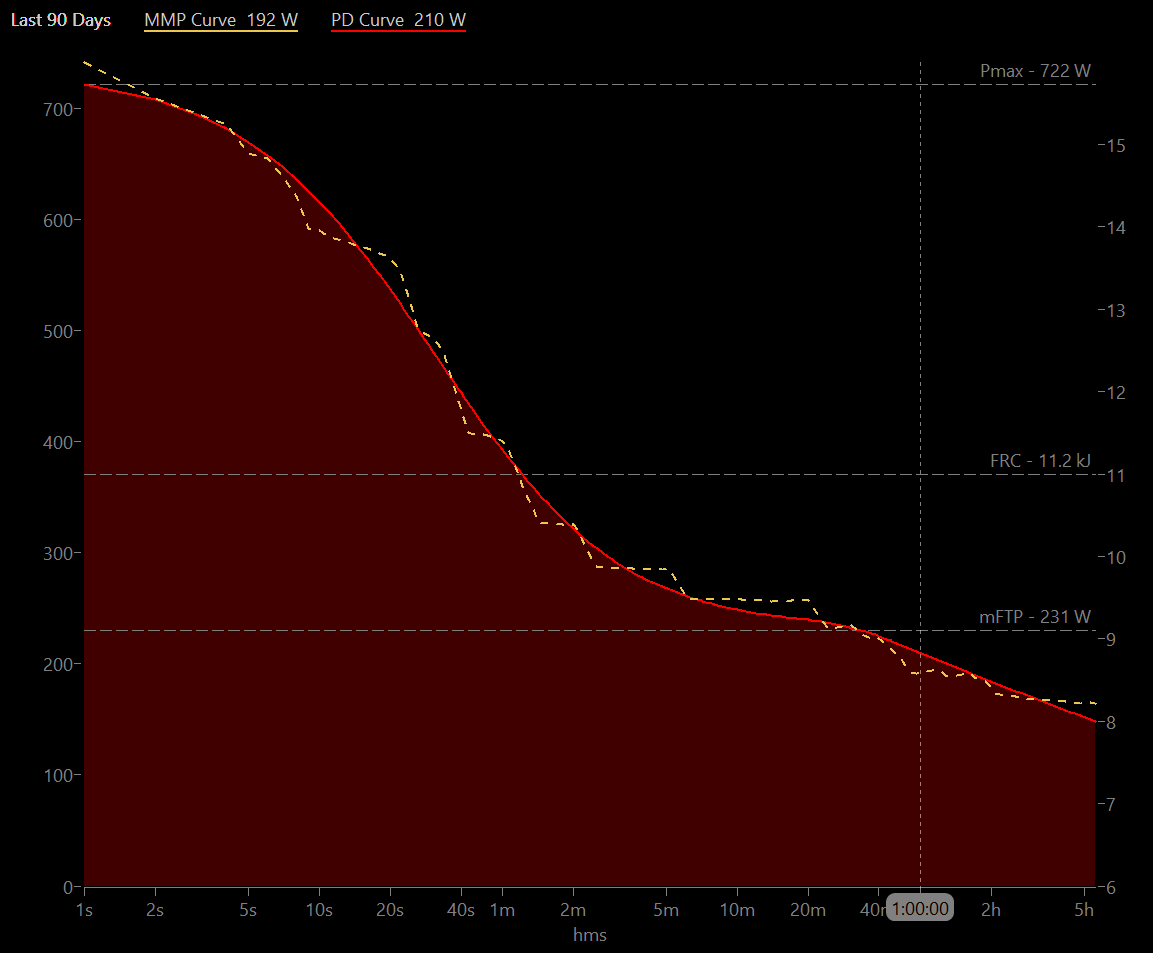So I've been having a play around with WKO4 in the off-season and have some questions about the Power-Duration model. I'm not looking to start an argument, just genuinely interested in some other opinions from those that have a bit more experience of it.
As a bit of a background, my last race of the season was at the end of August, I had about 4 weeks of relaxing/easy unstructured training and then 6 full weeks of structured base training. This weekend I conducted a bit of baseline testing to try to track my winter training progress, with a traditional 20-min FTP test on Saturday and a short-duration test of mostly anaerobic intervals (30s, 1 min, 2 min and 5 min durations) on Tuesday, loosely based on the traditional Hunter Allen & Andrew Coggan power profiling assessment. I synced all of this data into WKO4 and took a look at the Power-Duration model that it had calculated for me; the dataset includes another 60 or so workouts, however these are mostly eclipsed by the maximal efforts from these tests.
As expected the raw data was rather jagged, with obvious "steps" in the Mean-Max Power profile evident for each discrete test duration (see below). The issue that I have is that the Power-Duration curve that WKO4 has calculated basically takes an averaged fit across this whole profile rather than better accounting for durations of truly maximal effort. As a result, your PD curve is dragged down by any duration period for which you haven't performed an effort reasonably close to maximal. My case is clearly an extreme example of this, being based on a somewhat limited dataset, but it appears to me that even with a (much) larger and more diverse set of data, it's still fundamentally predisposed to underestimate your true capacity at a given duration.
As an example, just to the right-of-centre of my chart are 2 big steps for my 5 min and 20 min testing intervals; the MMP data drops off sharply after these durations and drags the PD-curve down to significantly underestimate my capacity at these intervals. The obvious riposte to this is that the model can only work with the data that it's fed, but I'd argue that it should be calculated to better account for truly maximal efforts and that any MMP data point should represent a minimum value for the corresponding point on the PD-curve. It seems that if you're using the PD-curve to judge recent performance (e.g. the last 90 days) then most athletes won't be conducting enough truly maximal efforts across a broad enough range of durations for the current model to be accurate.
Any thoughts?
Please excuse my woeful numbers here, it's the off-season; that's my excuse and I'm sticking to it! :D

As a bit of a background, my last race of the season was at the end of August, I had about 4 weeks of relaxing/easy unstructured training and then 6 full weeks of structured base training. This weekend I conducted a bit of baseline testing to try to track my winter training progress, with a traditional 20-min FTP test on Saturday and a short-duration test of mostly anaerobic intervals (30s, 1 min, 2 min and 5 min durations) on Tuesday, loosely based on the traditional Hunter Allen & Andrew Coggan power profiling assessment. I synced all of this data into WKO4 and took a look at the Power-Duration model that it had calculated for me; the dataset includes another 60 or so workouts, however these are mostly eclipsed by the maximal efforts from these tests.
As expected the raw data was rather jagged, with obvious "steps" in the Mean-Max Power profile evident for each discrete test duration (see below). The issue that I have is that the Power-Duration curve that WKO4 has calculated basically takes an averaged fit across this whole profile rather than better accounting for durations of truly maximal effort. As a result, your PD curve is dragged down by any duration period for which you haven't performed an effort reasonably close to maximal. My case is clearly an extreme example of this, being based on a somewhat limited dataset, but it appears to me that even with a (much) larger and more diverse set of data, it's still fundamentally predisposed to underestimate your true capacity at a given duration.
As an example, just to the right-of-centre of my chart are 2 big steps for my 5 min and 20 min testing intervals; the MMP data drops off sharply after these durations and drags the PD-curve down to significantly underestimate my capacity at these intervals. The obvious riposte to this is that the model can only work with the data that it's fed, but I'd argue that it should be calculated to better account for truly maximal efforts and that any MMP data point should represent a minimum value for the corresponding point on the PD-curve. It seems that if you're using the PD-curve to judge recent performance (e.g. the last 90 days) then most athletes won't be conducting enough truly maximal efforts across a broad enough range of durations for the current model to be accurate.
Any thoughts?
Please excuse my woeful numbers here, it's the off-season; that's my excuse and I'm sticking to it! :D